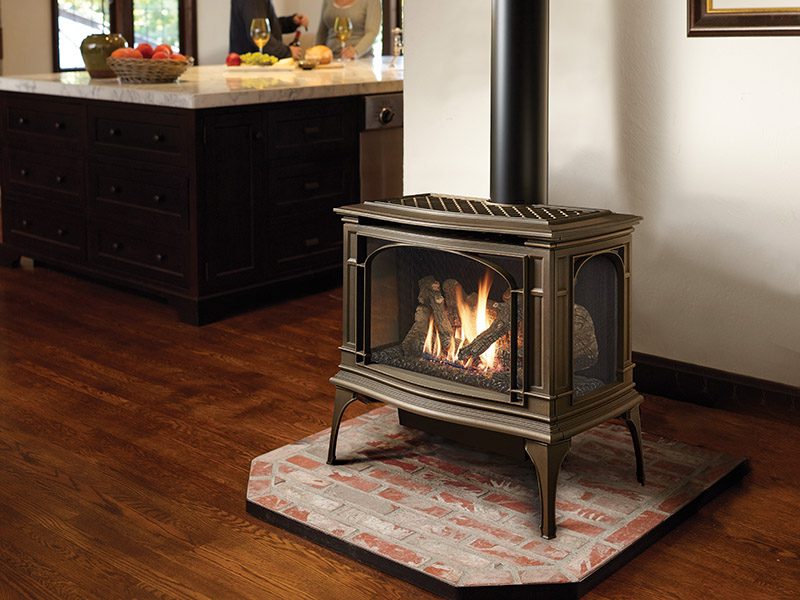With the winter months approaching, you might be thinking of making a change or updating your current gas heating stove. However, if it’s been a few years since you’ve looked at what’s available—or maybe a recent home purchase included a gas heating stove you’d like to replace—you might be unsure of what’s available for home heating.
If this sounds like you, you’ve come to the right place! In this blog, we’re going to explain the types of gas heating stoves, so you can make the best decision and purchase what works best for your home. And if you have additional questions, our helpful staff here at LanChester Grill & Hearth are ready to get you answers.
First Things First: Why Gas?
We’ve discussed the difference between gas, pellet, and wood stoves in previous blogs and how beneficial they are for your home, depending on your living space. Each fuel type has advantages, though gas stoves are often considered the most convenient for heating. For example, there is no wood to chop with a gas heating stove. You can also usually just flip a switch and have heat from the stove.
Pellet stoves use small wood pellets that you drop in the top to produce a fire, creating hot air that is blown into your living space. They require less fuel and can be compact, but unfortunately, pellet stoves use an electric motor that won’t work if a storm knocks out the electricity.
Wood-burning stoves can be expensive to install if you don’t already have a fireplace with a working chimney. Plus, if the idea of finding, chopping, and stacking your own firewood isn’t your idea of fun, then a wood-burning stove might not be the best choice.
So what about gas heating stoves and how they might fit your home best? Keep reading to learn more about the three kinds of gas heating stoves to help decide which will work best for your situation. You can also stop by our showroom to see the gas stoves we have in stock today!
What Are the Three Types of Gas Heating Stoves?
1. Direct Vent Gas Heating Stoves
A direct vent gas heating stove makes sense when your living space doesn’t have a flue or existing chimney. Instead, a direct vent is installed through an outer wall and allows outside air inside to aid with combustion. Direct vent stoves also recirculate air inside the home to warm the space and help reduce drafts.
Direct vent gas heating stoves allow flexibility when choosing a location. As long as there is access to an outside wall for the vent and an accessible fuel line, direct vent gas stoves can be used in spaces where fireplaces aren’t practical, like small bedrooms and workshops.
Most gas-burning stoves sold today are direct vents and are a popular choice for any home if a fireplace is not an option.
2. Natural Vent Gas Heating Stoves
A natural vent gas heating stove is also known as a B-vent. In some cases, it uses an existing chimney to allow combustion gases to rise naturally through a sealed pipe inside your chimney and be released into the air. Very few manufacturers produce natural vent stoves, and we do not carry any here at LanChester.
Natural vent stoves must be constructed to the same standards as a masonry chimney and should be installed by professionals to ensure proper adherence to local building codes. Plus, they are less efficient than direct vent stoves because they use room air for combustion, which you have already paid to heat. A direct vent uses fresh air from the outside, which gets preheated as it passes through the exhaust pipe, therefore using less energy. It’s free heated air!
3. Vent-Free Gas Heating Stoves
The last type of gas heating stove we’re going to discuss is a vent-free stove, which means there is no ventilation system to the outside. Instead, the unit is supplied fuel from a propane or gas source and processes the fuel through artificial ceramic fiber logs to create warm air.
Even though some vent-free stoves are more efficient than vented stoves, they should be used with caution. The stoves produce small amounts of carbon monoxide and nitrous dioxide, which can be deadly in large doses. Some states have outlawed ventless stoves because of these dangers.
At LanChester Grill & Hearth, we don’t recommend vent-free gas heating stoves and do not sell them in our showroom. Instead, our team of experts can help you find a solution for a vented gas heating stove, whether it’s a direct vent or natural vent gas stove.
Want to See a Gas Heating Stove in Action? Stop by Our Showroom Today!
Now that you know the different kinds of gas heating stoves, contact us today for more information or stop by our showroom in the Lancaster area to select the perfect gas heating stove to keep you warm during the long, cold winter months ahead. We will help you every step of the way with purchasing a gas heating stove that will serve your home for years to come.


